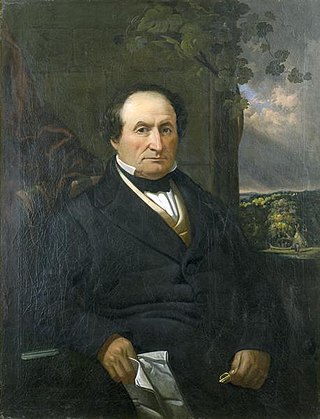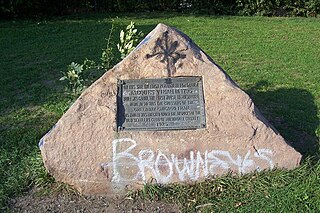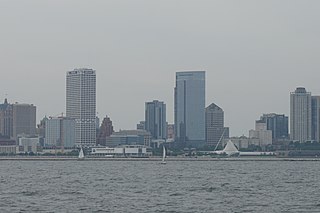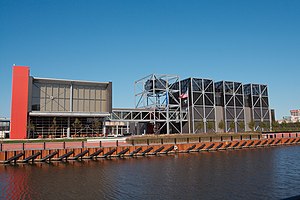
Milwaukee is a city in the U.S. state of Wisconsin and the county seat of Milwaukee County. With a population of 577,222 at the 2020 census, Milwaukee is the 31st largest city in the United States, the fifth-largest city in the Midwest, and the largest city in the state of Wisconsin.

Wauwatosa is a city in Milwaukee County, Wisconsin, United States. The population was 48,387 at the 2020 census. Wauwatosa is located immediately west of Milwaukee, and is a part of the Milwaukee metropolitan area. It is named after the Potawatomi Chief Wauwataesie and the Potawatomi word for firefly.

Mequon is the largest city in Ozaukee County, in the U.S. state of Wisconsin, and the third-largest city in Wisconsin by land area. Located on Lake Michigan's western shore with significant commercial developments along Interstate 43, the community is a suburb in the Milwaukee metropolitan area. Despite being an incorporated city, approximately half of Mequon's land is undeveloped and agriculture plays a significant role in the local economy. At the time of the 2010 census the population was 23,132.

The Fox River is a river in eastern Wisconsin in the Great Lakes region of the United States. It is the principal tributary of Green Bay, and via the Bay, the largest tributary of Lake Michigan. The well-known city of Green Bay, one of the first European settlements in North America, is on the river at its mouth on lower Green Bay.

Solomon Laurent Juneau, or Laurent-Salomon Juneau was a French Canadian fur trader, land speculator, and politician who helped found the city of Milwaukee, Wisconsin. He was born in Repentigny, Quebec, Canada to François and (Marie-)Thérèse Galarneau Juneau. His cousin was Joseph Juneau, who founded the city of Juneau, Alaska.
The Marquette Interchange is a major freeway interchange in downtown Milwaukee, Wisconsin, located near Marquette University where Interstate 43, I-94, and I-794 meet. Originally built in the 1960s, the interchange underwent a total rebuild between 2004 and 2008, and was officially opened on August 19, 2008, after what was at the time the largest construction project in state history. During the early 2000s, U.S. Highway 41 (US 41) had followed I-94 through the interchange. This had changed when I-41 was designated in the Milwaukee area. US 41 now follows I-41 through the Zoo Interchange instead.

Patrick Cudahy Jr. ; March 17, 1849 – July 25, 1919) was an American industrialist in the meat packing business and a patriarch of the Cudahy family.

The Milwaukee River is a river in the state of Wisconsin. It is about 104 miles (167 km) long. Once a locus of industry, the river is now the center of a housing boom. New condos now crowd the downtown and harbor districts of Milwaukee attracting young professionals to the area. The river is also ribboned with parks as it winds through various neighborhoods. Kayaks and fishing boats share the river with party boats. An extensive Riverwalk featuring art displays, boat launches and restaurants lines its banks in downtown Milwaukee.

Interstate 794 is a 3.75-mile (6.04 km) auxiliary Interstate Highway in Milwaukee County in the US state of Wisconsin. It is one of two auxiliary Interstates in the Milwaukee metropolitan area, serves the lakefront and the Port of Milwaukee, and connects downtown with the southeastern suburbs of St. Francis, Cudahy, and South Milwaukee.

Jacques Vieau was a French-Canadian fur trader and the first permanent white settler in Milwaukee, Wisconsin. He was born near Montreal, Quebec, Canada and died in Howard, Wisconsin.

Potawatomi Hotel & Casino, formerly Potawatomi Bingo Casino, is a Native American casino in Milwaukee, Wisconsin, United States, owned and operated by the Forest County Potawatomi Community. It first opened its doors March 7, 1991. Located on Canal Street in the Menomonee Valley near Downtown Milwaukee, this entertainment destination offers a variety of entertainment options, including a 20-table poker room, multiple restaurants and dining options, a food court, a sports book, and the Sky Lodge. It's a popular destination spot for visitors outside of Milwaukee.

The neighborhoods of Milwaukee include a number of areas in southeastern Wisconsin within the state's largest city at nearly 600,000 residents.
Milwaukee, Wisconsin's history, which includes over 160 years of immigration, politics, and industry, has given it a distinctive heritage.

Oops, Missed is a public artwork by American Bernard Peck located at 1515 West Canal Street, just off the 16th street viaduct, in Milwaukee, Wisconsin, United States. It was dedicated in July 1987. It is made of brick and stainless steel.

Valley Fields is a 1,750-seat outdoor stadium and practice facility in Milwaukee, Wisconsin, primarily used by the varsity men's and women's soccer and lacrosse teams at Marquette University, all of which compete in the Big East Conference. The complex houses bleachers, locker rooms, practice fields and a main stadium.

The Court Street Commercial Historic District is a largely intact part of the old downtown of Richland Center, Wisconsin. It was added to the National Register of Historic Places in 1989 - a 11.2 acres (4.5 ha) historic district which included 51 contributing buildings and 20 non-contributing ones. The buildings are commercial, mostly in Late Victorian styles constructed from 1870 to 1938. Most are brick two-story buildings; a few one-story and three-story brick buildings are interspersed.
Pfister & Vogel (P&V) was an American tannery business in Milwaukee, Wisconsin.

The Walker's Point Historic District is a mixed working-class neighborhood of homes, stores, churches and factories in Milwaukee, Wisconsin, with surviving buildings as old as 1849, including remnants of the Philip Best Brewery and the Pfister and Vogel Tannery. In 1978 it was added to the National Register of Historic Places. The NRHP nomination points out that Walker's Point was "the only part of Milwaukee's three original Settlements to reach the last quarter of the Twentieth Century with its Nineteenth and early-Twentieth Century fabric still largely intact," and ventures that "For something similar, one would have to travel to Cleveland or St. Louis if, indeed, so cohesive and broad a grouping of...structures still exists even in those cities."

In Milwaukee, freeways were constructed in response to an 8.5% increase in population during the 1940s. Road plans were drawn up in the 1950s through the 1970s and several freeways were built. A lack of foresight resulted in several communities experiencing sharp increases in property taxes such as in West Milwaukee, or the complete destruction of vibrant, African-American neighborhoods such as Bronzeville. After a decade of aggressive highway building in the 1960s, support for freeway construction began to wane as neighborhoods started to oppose construction. With the election of John Norquist as mayor in 1988, Milwaukee began to undo some of the damage of its highway construction. The dismantling of the Park East Freeway north of downtown led to a housing and entertainment construction boom and is the location of Fiserv Forum.

Downtown Milwaukee is the central business district of Milwaukee, Wisconsin. The economic and symbolic center of the city and the Milwaukee metropolitan area, it is Milwaukee's oldest district and home to many of region's cultural, financial educational and historical landmarks including Milwaukee City Hall, Fiserv Forum and the Milwaukee Art Museum. The city's modern history began in Downtown Milwaukee in 1795 when fur trader Jacques Vieau (1757–1852) built a post along a bluff on the east side, overlooking the Milwaukee and Menomonee rivers.





















